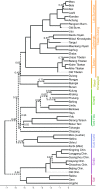Dated language phylogenies shed light on the ancestry of Sino-Tibetan - PubMed (original) (raw)
Dated language phylogenies shed light on the ancestry of Sino-Tibetan
Laurent Sagart et al. Proc Natl Acad Sci U S A. 2019.
Abstract
The Sino-Tibetan language family is one of the world's largest and most prominent families, spoken by nearly 1.4 billion people. Despite the importance of the Sino-Tibetan languages, their prehistory remains controversial, with ongoing debate about when and where they originated. To shed light on this debate we develop a database of comparative linguistic data, and apply the linguistic comparative method to identify sound correspondences and establish cognates. We then use phylogenetic methods to infer the relationships among these languages and estimate the age of their origin and homeland. Our findings point to Sino-Tibetan originating with north Chinese millet farmers around 7200 B.P. and suggest a link to the late Cishan and the early Yangshao cultures.
Keywords: East Asia; Sino-Tibetan languages; computer-assisted language comparison; human prehistory; peopling.
Copyright © 2019 the Author(s). Published by PNAS.
Conflict of interest statement
The authors declare no conflict of interest.
Figures
Fig. 1.
Languages in our sample, contrasted with ancient sites reflecting early stages of domestication and the estimated spread of non-Sinitic languages (see Homeland, Archaeology, and Agriculture). Ancient language locations reflect supposed political and cultural epicenters of the varieties.
Fig. 2.
The Maximum Clade Credibility tree from the best-fitting model (relaxed clock with covarion). Branches with less than 0.8 posterior probability are dashed; other branches have posterior probabilities >0.8. For densitrees of the data, see
SI Appendix, section 4
.
Similar articles
- Phylogenetic evidence for Sino-Tibetan origin in northern China in the Late Neolithic.
Zhang M, Yan S, Pan W, Jin L. Zhang M, et al. Nature. 2019 May;569(7754):112-115. doi: 10.1038/s41586-019-1153-z. Epub 2019 Apr 24. Nature. 2019. PMID: 31019300 - Archaeological evidence for initial migration of Neolithic Proto Sino-Tibetan speakers from Yellow River valley to Tibetan Plateau.
Liu L, Chen J, Wang J, Zhao Y, Chen X. Liu L, et al. Proc Natl Acad Sci U S A. 2022 Dec 20;119(51):e2212006119. doi: 10.1073/pnas.2212006119. Epub 2022 Dec 12. Proc Natl Acad Sci U S A. 2022. PMID: 36508670 Free PMC article. - Dated phylogeny suggests early Neolithic origin of Sino-Tibetan languages.
Zhang H, Ji T, Pagel M, Mace R. Zhang H, et al. Sci Rep. 2020 Nov 27;10(1):20792. doi: 10.1038/s41598-020-77404-4. Sci Rep. 2020. PMID: 33247154 Free PMC article. - Coevolution of languages and genes.
Pakendorf B. Pakendorf B. Curr Opin Genet Dev. 2014 Dec;29:39-44. doi: 10.1016/j.gde.2014.07.006. Epub 2014 Aug 28. Curr Opin Genet Dev. 2014. PMID: 25170984 Review. - Tracing population movements in ancient East Asia through the linguistics and archaeology of textile production.
Nelson S, Zhushchikhovskaya I, Li T, Hudson M, Robbeets M. Nelson S, et al. Evol Hum Sci. 2020 Feb 14;2:e5. doi: 10.1017/ehs.2020.4. eCollection 2020. Evol Hum Sci. 2020. PMID: 37588355 Free PMC article. Review.
Cited by
- Genomic insights into the genetic structure and population history of Mongolians in Liaoning Province.
Hou X, Zhang X, Li X, Huang T, Li W, Zhang H, Huang H, Wen Y. Hou X, et al. Front Genet. 2022 Oct 12;13:947758. doi: 10.3389/fgene.2022.947758. eCollection 2022. Front Genet. 2022. PMID: 36313460 Free PMC article. - Forensic Efficiency Estimation of a Homemade Six-Color Fluorescence Multiplex Panel and In-Depth Anatomy of the Population Genetic Architecture in Two Tibetan Groups.
Liu Y, Cui W, Jin X, Wang K, Mei S, Zheng X, Zhu B. Liu Y, et al. Front Genet. 2022 May 27;13:880346. doi: 10.3389/fgene.2022.880346. eCollection 2022. Front Genet. 2022. PMID: 35692824 Free PMC article. - Automated identification of borrowings in multilingual wordlists.
List JM, Forkel R. List JM, et al. Open Res Eur. 2022 Mar 23;1:79. doi: 10.12688/openreseurope.13843.3. eCollection 2021. Open Res Eur. 2022. PMID: 37645101 Free PMC article. - Extensive Ethnolinguistic Diversity in Vietnam Reflects Multiple Sources of Genetic Diversity.
Liu D, Duong NT, Ton ND, Van Phong N, Pakendorf B, Van Hai N, Stoneking M. Liu D, et al. Mol Biol Evol. 2020 Sep 1;37(9):2503-2519. doi: 10.1093/molbev/msaa099. Mol Biol Evol. 2020. PMID: 32344428 Free PMC article. - Cultural variation impacts paternal and maternal genetic lineages of the Hmong-Mien and Sino-Tibetan groups from Thailand.
Kutanan W, Shoocongdej R, Srikummool M, Hübner A, Suttipai T, Srithawong S, Kampuansai J, Stoneking M. Kutanan W, et al. Eur J Hum Genet. 2020 Nov;28(11):1563-1579. doi: 10.1038/s41431-020-0693-x. Epub 2020 Jul 20. Eur J Hum Genet. 2020. PMID: 32690935 Free PMC article.
References
- Hammarström H, Forkel R, Haspelmath M. Glottolog. MPI-SHH; Jena, Germany: 2018.
- Allentoft ME, et al. Population genomics of Bronze Age Eurasia. Nature. 2015;522:167–172. - PubMed
- Garnier R, Sagart L, Sagot B. Language Dispersal Beyond Farming. John Benjamins; Amsterdam: 2017. Milk and the Indo-Europeans; pp. 291–311.
Publication types
MeSH terms
LinkOut - more resources
Full Text Sources

